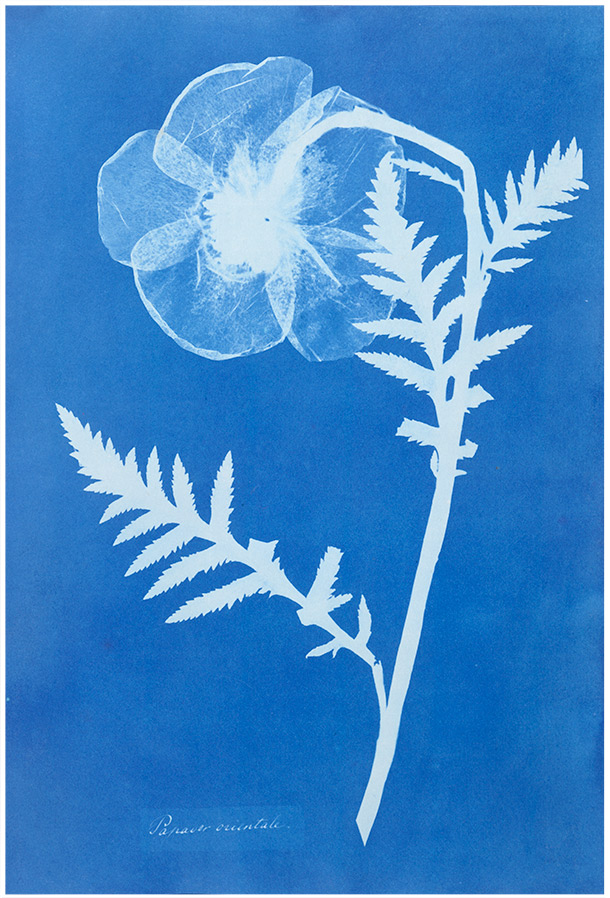Women of Colour:
Anna Atkins, Color Photography
and Those Struck by Light
Project by Ellen Carey
Anna Atkins, Poppy, about 1852
Museum no. PH. 381-1981
© Victoria and Albert Museum, London
––
My research on the origins and history of color photography noted an absence that prompted a question: “Where would color photography and women practitioners be without the work of Anna Atkins?" The British Victorian, Anna Atkins (1799-1871), was the first woman photographer, albeit cameraless, and the first in color, using the cyanotype, a method that yielded a Prussian blue. Sir John Herschel, the British scientist, taught her his method. She partnered it with Talbot’s photogram (1834) — his paper negative image, a ghostly outline of the object, such as fern leaf or lace, in non-color, produced a palette of earthy browns. Gender codes of Atkins’ blue/feminine versus Talbot’s brown/masculine (italics mine) underscore these divisions of content, context, and concept, adding to the discourse around male and female sight.
Her cyanotype-as-photogram includes her handwriting, another first. Writing as “word art” is born, delicately seen in her cursive, filigree descriptions, in and around her botanical and nature studies. I am of the opinion that her compositions are precursors to abstraction and minimalism in photography, noted for their sophisticated, elegant arrangements that highlight her keen visual intelligence. Her work points the way to these less-is-more art movements through off-frame space, symmetry and asymmetry, reductive palette, rectangular frame-as-active picture plane, line-as-open form, size, and scale, thinking conceptually toward the end results. Her actions are fluid and highly sensitive, powerful in their visual impact, and no bigger than a sheet of paper or a small page in a book. One of seventeen existing portfolios is in the New York Public Library’s collection; rarer still for its pristine condition and original wrappings, it is highly prized.
Color is light, seen in nature as a rainbow, and light is photography’s indexical. Photogram and cyanotype are transformed through the agency of nature; “sun pictures” double and mirror the phrase drawing with light. Anna Atkins is a Woman of Colour struck by light — inspiration — that begins the discourse around color and photography as object and form and technical and visual advancement. What is absent? My hypothesis supports the singular recognition of women practitioners, whose historical and contemporary collective contributions in color photography remain “under-exposed,” to borrow a traditional photographic term.
Women of Colour advances fresh, new scholarship through a distinct and separate category, tracing its origins to gender-specificity. In doing so, it challenges and reframes the big question posed by the American art historian, Linda Nochlin, in her groundbreaking essay (1971) published in ArtNews: “Why Have There Been No Great Women Artists?” Today, almost a half-century later, the answer to Nochlin’s question in art and feminist debates, art history and criticism, art world and marketplace proves this has improved, but still exists. My femme brut(e) is a curatorial phrase I developed to describe this bias, bringing it to the surface for (re)examination; it celebrates all the great women artists. My research finds color blindness probably existed with gender blindness.
Photography is well populated by great women practitioners, many using color: “Why?” Are there social, economic, or political reasons? Color is technically challenging and expensive, especially in photography. Does this fact underscore female power, financial autonomy, and break taboos of physical strength, visual intelligence, and “woman artist” stereotypes in art, science, and chemistry? What was photography’s role in this?
Why do women photographers choose color? What are the aesthetic reasons? How are they gender-driven? Is color more “attractive” or was it because originally photography was an “empty” field? Women for the first time freed themselves from the margins of art history because photography wasn’t considered serious or an art form. So, does practicing color offer paradoxically more freedom? The British late Victorian, Lady Sarah Angelina Acland, follows Atkins in the ‘Sanger-Shepard’ color process. My big question: “Who was first in color photography?” This person was definitely British and female and living in the 19th century! Colour, the British English spelling, highlights its origins as England.
Women of Colour: Anna Atkins, Color Photography, and Those Struck by Light provides a scholarly context highlighting women and color photography. A lecture/panel/exhibit would give my hypothesis a robust opportunity since this political phrase is purposely attention-grabbing. In addition to Atkins and Acland, my proposal and presentation includes the late Sarah Charlesworth and Jan Groover; Marie Cosines, who worked with Dr. Edwin Land to develop Polaroid color; African-American photographers Renee Cox, Lorna Simpson and Carrie Mae Weems (US); Susan Derges (UK), Liz Deschenes, Barbara Kasten, Cindy Sherman, Sandy Skoglund (US), and others (list TBA). It offers a glimpse into my new scholarship and startling theory. New scientific data shows that a DNA gene called tetrachromacy allows some women an increased ability to perceptually see, perhaps have a greater understanding in color. Having four cones instead of 3 significantly multiplies the amount of color one can discern; color blindness is 20 times more frequent in men. Is this groundbreaking news the first broadcast from the dawn of photography — in color photographic images — of and by women practitioners, from then until now?
Color orbits an artist’s universe; color theory (RGB=YMC) is photography’s planet. In partnership with other disciplines, new discourses expand: theory/art history, feminism/photography, aesthetics/technology, and gender psychology/biology of seeing. My practices as Photography Degree Zero (1996-2011) and Struck by Light (1992-2014) contribute to this dialogue. I am a “woman of color.” My scholarship known as Pictus & Writ (2008-2014) sees published essays on Sol LeWitt and Man Ray. “What is color?” — nature, innovation, wonder, invention — a wheel spinning creative opportunities for Women of Colour: Anna Atkins, Color Photography and Those Struck by Light.

